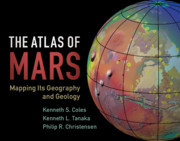Description
The Atlas of Mars
Mapping its Geography and Geology
Authors: Coles Kenneth S., Tanaka Kenneth L., Christensen Philip R.
A richly illustrated and stunning visual reference work on Mars, replacing the NASA atlas from the 1970s.
Language: English
Subject for The Atlas of Mars:
54.78 €
In Print (Delivery period: 14 days).
Add to cart
Publication date: 08-2019
300 p. · 36.3x28.5 cm · Hardback
300 p. · 36.3x28.5 cm · Hardback
Description
/li>Contents
/li>Biography
/li>
Planetary scientist and educator Ken Coles has teamed up with Ken Tanaka from the United States Geological Survey's Astrogeology team, and Phil Christensen, Principal Investigator of the Mars Odyssey orbiter's THEMIS science team, to produce this all-purpose reference atlas, The Atlas of Mars. Each of the thirty standard charts includes: a full-page color topographic map at 1:10,000,000 scale, a THEMIS daytime infrared map at the same scale with features labeled, a simplified geologic map of the corresponding area, and a section describing prominent features of interest. The Atlas is rounded out with extensive material on Mars' global characteristics, regional geography and geology, a glossary of terms, and an indexed gazetteer of up-to-date Martian feature names and nomenclature. This is an essential guide for a broad readership of academics, students, amateur astronomers, and space enthusiasts, replacing the NASA atlas from the 1970s.
Preface; Acknowledgements; How to use this Atlas; 1. Introduction; 2. History of exploration of Mars; 3. Global character of Mars; 4. Regional geographic features and surface views of Mars; 5. Geology of Mars; 6. Map sheets 1-30; Appendices: units on geologic map of Mars; Unit conversions; Abbreviations; Glossary of terms; Latin descriptors; Gazetteer; References; Sources of images; Index.
Kenneth S. Coles is Associate Professor and Planetarium Director at Indiana University of Pennsylvania. An award winning teacher, he has dedicated his career to sharing planetary science and geology discoveries with university students, schoolchildren, and the public.
Kenneth L. Tanaka is a geologist retired from the US Geological Survey Astrogeology Science Center in Flagstaff, Arizona. He has thirty-five years of experience in the geologic mapping of Mars, informing NASA's exploration missions, and has received the US Department of Interior's Distinguished Service Award.
Philip R. Christensen is Regents' Professor of Planetary Geoscience at Arizona State University. He is the Principal Investigator for the Mars Odyssey THEMIS instrument and has received the Geological Society of America's G. K. Gilbert Award, NASA's Exceptional Scientific Achievement Medal, and NASA's Public Service Medal.
Kenneth L. Tanaka is a geologist retired from the US Geological Survey Astrogeology Science Center in Flagstaff, Arizona. He has thirty-five years of experience in the geologic mapping of Mars, informing NASA's exploration missions, and has received the US Department of Interior's Distinguished Service Award.
Philip R. Christensen is Regents' Professor of Planetary Geoscience at Arizona State University. He is the Principal Investigator for the Mars Odyssey THEMIS instrument and has received the Geological Society of America's G. K. Gilbert Award, NASA's Exceptional Scientific Achievement Medal, and NASA's Public Service Medal.
© 2024 LAVOISIER S.A.S.

